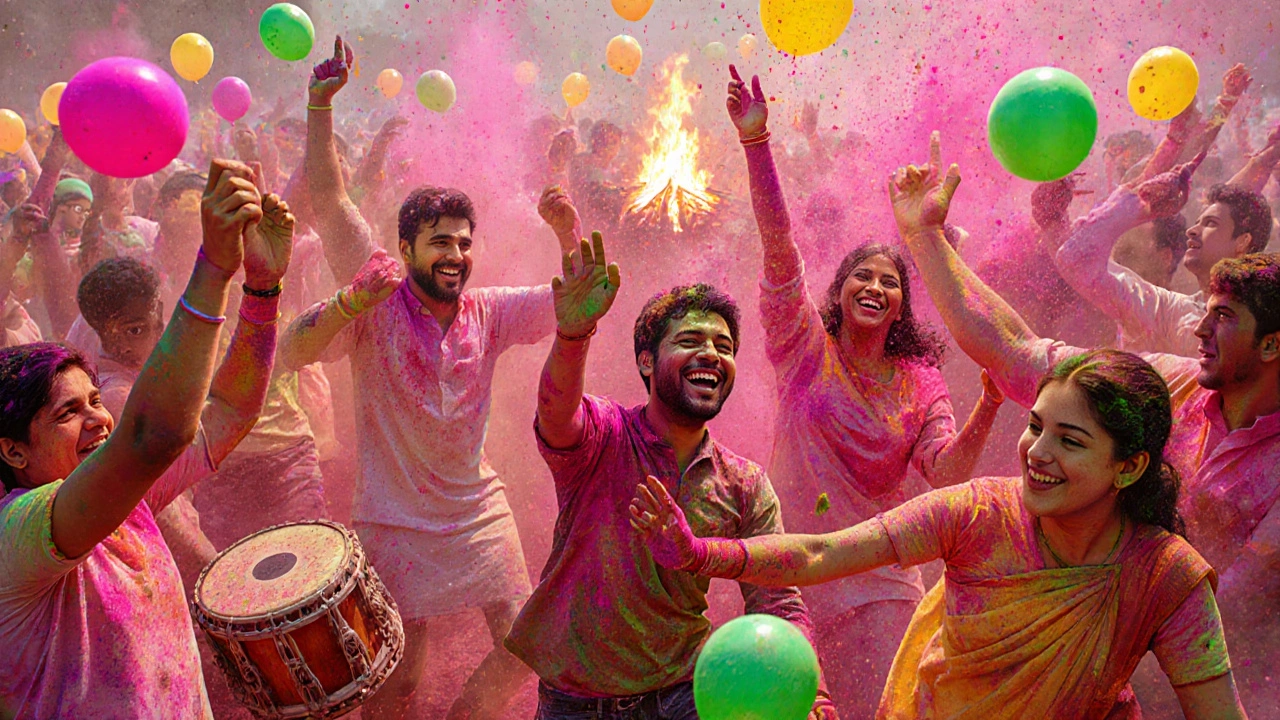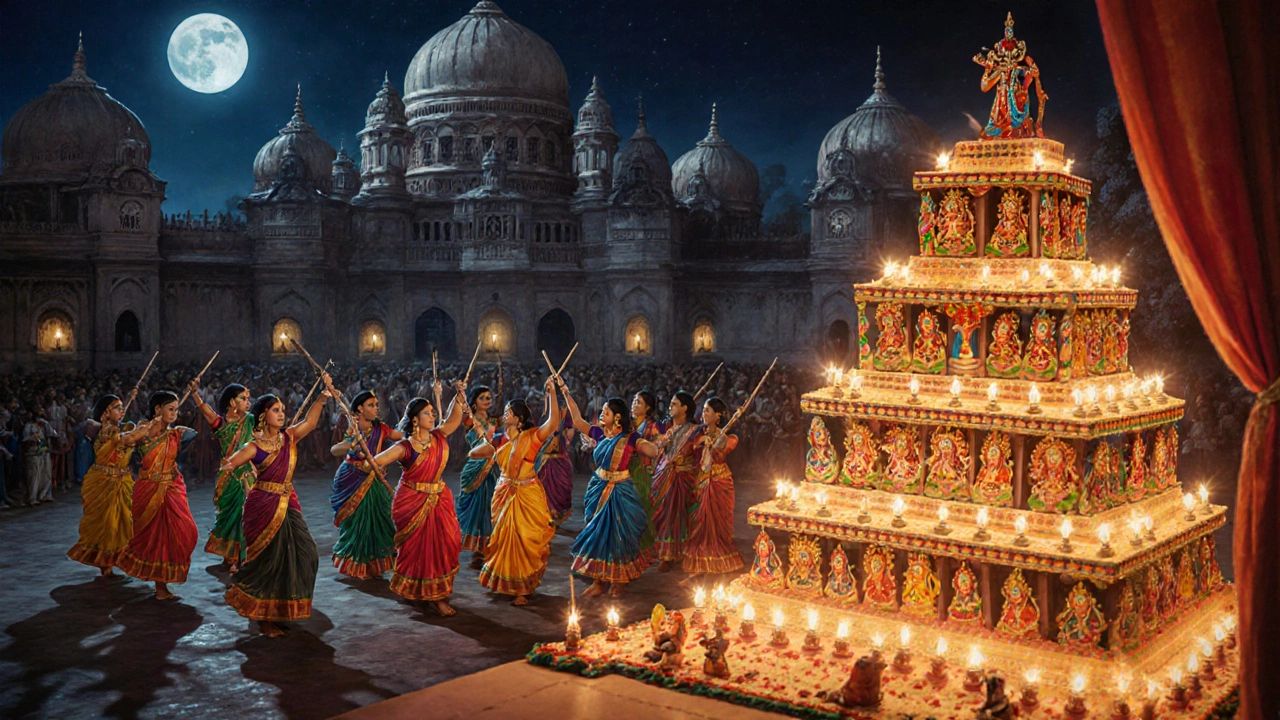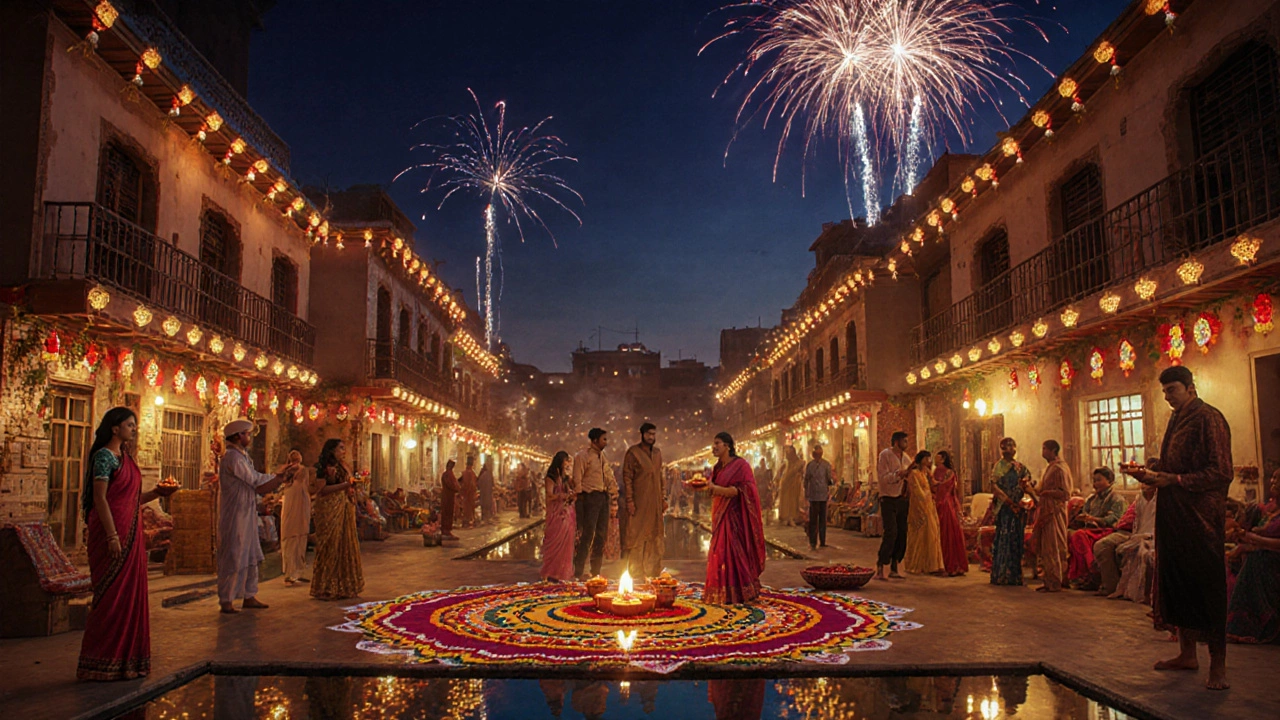Hindu Festival Date Calculator
If you’ve ever seen streets lit up with thousands of diyas, heard the sound of dhol drums, or watched people throwing colored powder in the air, you’ve witnessed one of Hinduism’s biggest celebrations. But what are the three major holidays that shape the spiritual and cultural rhythm of over a billion people? These aren’t just parties-they’re deep-rooted traditions tied to ancient stories, seasonal shifts, and the eternal cycle of light over darkness, good over evil.
Diwali: The Festival of Lights
Diwali, also called Deepavali, is the most widely celebrated Hindu holiday. It falls between mid-October and mid-November, depending on the lunar calendar. In 2025, it lands on November 12. For five days, homes across India and beyond are cleaned, decorated with rangoli patterns, and lit with oil lamps. Families gather, exchange sweets, and light fireworks to welcome Lakshmi, the goddess of wealth and prosperity.
But Diwali isn’t just about money. In northern India, it marks the return of Lord Rama to Ayodhya after 14 years in exile and his victory over the demon king Ravana. In southern India, it celebrates Lord Krishna defeating the demon Narakasura. In western India, it’s tied to the day Lord Vishnu sent the demon king Bali to the netherworld. Each region tells a different story, but the meaning is the same: light conquers darkness, knowledge over ignorance.
What makes Diwali stand out? It’s the scale. Over 1.3 billion people participate. In India alone, more than 200,000 tons of fireworks are set off in a single night. Homes are decorated with electric lights, candles, and intricate sand art. Businesses close for the holiday and reopen on the fifth day with new ledgers-symbolizing fresh starts.
Holi: The Festival of Colors
Holi arrives in March, usually around the full moon of the Hindu month of Phalguna. In 2025, it’s on March 14. It’s the one holiday where you’re not just allowed to get messy-you’re expected to. People drench each other in bright powders and water, dance to folk songs, and share sweets like gujiya and thandai.
The origins go back to Hindu mythology. One version tells of Prahlad, a young devotee of Lord Vishnu, who survived a fire set by his evil aunt Holika. The fire burned her but spared him, symbolizing the triumph of faith over malice. Another story links Holi to Lord Krishna, who playfully painted the face of his beloved Radha with color, starting the tradition of joyful mischief.
What makes Holi unique is how it breaks down social barriers. Caste, class, age, and gender fade away for a day. CEOs paint their cleaners. Teachers join students. Strangers hug and throw color at each other. In rural villages, bonfires are lit the night before-called Holika Dahan-to burn effigies of evil. The next day, the air is thick with pink, green, and yellow dust. It’s not just a festival; it’s a reset button for relationships.
Modern Holi has spread globally. Cities like Toronto, London, and Sydney host Holi festivals with thousands of attendees. But the heart of it remains in India-where the colors are made from natural flowers and herbs, not synthetic dyes. Many families still prepare their own colors from turmeric, neem, and hibiscus.
Navaratri: Nine Nights of Divine Energy
Navaratri means "nine nights" in Sanskrit. It happens twice a year, but the biggest celebration is in autumn, around September-October. In 2025, it runs from October 1 to October 9. During these nine days, devotees honor the goddess Durga in her nine forms, each representing a different power-strength, wisdom, courage, compassion, and more.
In Gujarat, people dance Garba and Dandiya Raas every night in circles, clapping sticks and spinning in colorful clothes. In West Bengal, it’s Durga Puja-the most elaborate version. Huge pandals (temporary temples) are built, filled with statues of Durga slaying the buffalo demon Mahishasura. Millions visit these displays, some traveling hundreds of kilometers just to see them.
In southern India, especially Tamil Nadu and Karnataka, homes set up Kolu displays-rows of dolls and figurines arranged on stepped platforms. Each step represents a different realm: gods, kings, farmers, artisans. Families invite guests to view the display, share meals, and exchange gifts.
The tenth day, Vijayadashami or Dussehra, marks the end. It celebrates the victory of good over evil. In northern India, effigies of Ravana are burned. In the south, people worship tools, books, and vehicles-acknowledging that knowledge and work are sacred too. Children receive new books. Artists present their work. Even cars are blessed.
What’s striking about Navaratri is how it turns daily life into worship. Women wear new saris. Men wear dhotis. Music fills the air. For nine days, the rhythm of life slows down to honor the feminine divine. It’s not just about ritual-it’s about remembering that power comes in many forms.

Why These Three Stand Out
There are hundreds of Hindu festivals. Why do Diwali, Holi, and Navaratri rise above the rest?
First, they’re celebrated across almost every region of India-north, south, east, west. While local customs vary, the core meaning stays the same. Second, they’re tied to natural cycles: Diwali after harvest, Holi at the end of winter, Navaratri before winter. They mark time in a way that connects people to the earth.
Third, they involve everyone. Children light diyas. Elders chant prayers. Young people dance. Even non-Hindus join in. In Australia, where I live in Brisbane, you’ll find Diwali light-ups at South Bank, Holi color runs at New Farm Park, and Garba nights at community centers. These aren’t niche events-they’re shared cultural moments.
Unlike holidays that focus on one deity or one story, these three cover the full spectrum of human experience: joy (Holi), renewal (Diwali), and devotion (Navaratri). They’re not just religious-they’re emotional, social, and deeply human.
What You’ll See During Each Festival
- Diwali: Diyas (oil lamps), fireworks, rangoli art, sweets like laddoo and jalebi, family gatherings, new clothes, temple visits, business new year rituals.
- Holi: Colored powder (gulal), water balloons, bonfires, thandai (spiced milk drink), dhol music, street dancing, forgiveness rituals, communal feasts.
- Navaratri: Garba and Dandiya dancing, Kolu doll displays, Durga idols, fasting, chanting of Devi Mahatmyam, offerings of flowers and fruits, Vijayadashami book blessings.

Common Misconceptions
Some think Hinduism is just about gods and rituals. But these three festivals show it’s really about lived experience. You don’t need to be Hindu to feel the meaning of Diwali’s light, Holi’s joy, or Navaratri’s energy.
Another myth: these are only Indian holidays. In fact, Nepal, Sri Lanka, Fiji, Mauritius, Trinidad, and even parts of Southeast Asia celebrate them with deep devotion. In the U.S., over 2 million people attend Diwali events each year.
And no, they’re not just "Indian Christmas." They’re not commercialized holidays with gift-giving as the main goal. The gifts are secondary. The real gift is connection-to family, to nature, to something bigger than yourself.
How to Respect These Festivals
If you’re invited to a Diwali dinner, bring sweets, not flowers. At Holi, wear clothes you don’t mind staining. During Navaratri, ask before taking photos of the Kolu display-it’s a sacred space.
Don’t treat them as exotic performances. These are sacred times for millions. The colors aren’t just for Instagram. The lamps aren’t just decorations. They’re prayers made visible.
Are Diwali, Holi, and Navaratri the only major Hindu holidays?
No, there are many others-like Raksha Bandhan, Ganesh Chaturthi, and Janmashtami. But Diwali, Holi, and Navaratri are the most widely observed across all regions of India and among the global Hindu diaspora. They’re the ones that shape the annual rhythm for most families.
Do all Hindus celebrate these three the same way?
No. Regional differences are strong. In Tamil Nadu, Diwali is linked to Krishna’s victory over Narakasura, while in Bengal, it’s tied to Kali worship. Holi is more wild in Uttar Pradesh than in Kerala. Navaratri is a dance festival in Gujarat but a temple festival in Odisha. The core meaning stays the same, but how it’s expressed varies by culture, language, and history.
Can non-Hindus participate in these festivals?
Absolutely. Many non-Hindus join in Holi color runs, attend Diwali light shows, and watch Garba performances. The key is to participate respectfully-ask questions, follow local customs, and avoid turning sacred rituals into photo ops. These festivals are open to all who come with joy and humility.
Why do the dates of these festivals change every year?
Hindu festivals follow the lunar calendar, not the Gregorian one. That means their dates shift by about 10-12 days each year. Diwali, for example, always falls on the new moon night of Kartik month. So while it’s always in October or November, the exact date changes. This keeps the festivals in sync with nature’s cycles-moon phases, harvest times, seasonal transitions.
What’s the best way to experience these festivals if I’m not in India?
Look for local Hindu community centers or cultural associations in your city. In Brisbane, Melbourne, or Sydney, you’ll find Diwali events at the Hindu Temple, Holi parties at community parks, and Navaratri Garba nights hosted by Indian cultural groups. Many are open to the public. You can also join online streams from temples in Varanasi or Mumbai-some even offer live prayers and storytelling.
Final Thought
These three holidays aren’t just about rituals. They’re about remembering what matters: light after darkness, joy after hardship, devotion after doubt. Whether you’re lighting a lamp in your window, throwing color at a friend, or dancing in a circle under the stars-you’re joining a tradition older than most nations on Earth. And that’s something worth celebrating, no matter where you’re from.
